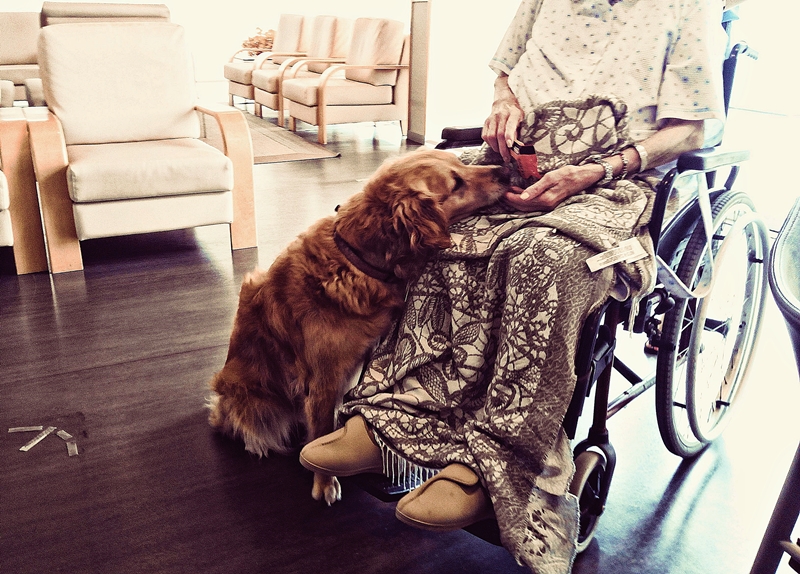
Animal therapy in palliative care: an intervention proposal to provide integrated care to people at the end of life.
From its origins, the human being has been shown to have a strong bond with nature and in particular with animals, a relationship that over time has attracted the interest of researchers and professionals, and of which there is a large body of scientific evidence that supports the beneficial effects of this interaction on human health.
Likewise, different studies have pointed out how animal companionship promotes the processes of recovery and healing in hospital contexts, as well as providing beneficial effects on the quality of life of both healthy individuals and people with acute and chronic illnesses.
Animal-Assisted Therapy (AAT) is a goal-directed intervention in which an animal is an integral part of a treatment process that aims to promote improvement in the physical, psychosocial, cognitive and/or emotional functions of the people treated. Directed by a specialized health care professional, the therapy includes specific goals and objectives for each individual based on their progress.
Keys and benefits of animal assisted therapy
With regard to the work that has analysed the impact of this type of intervention, especially dog-assisted therapy, studies coincide in pointing out an increase in the sense of well-being among the participants, as well as an improvement in their state of mind and their quality of life. In addition, it should be added that this therapeutic approach also contributes to providing meaning and purpose in life, as well as having a social facilitating effect, promoting the construction of the patient-healthcare relationship, and increasing interactions between the people we accompany, their families and professionals.
Finally, it is observed that the company of animals slightly reduces the sensations of pain and feelings of anxiety, along with an increase in positive emotions such as joy, entertainment and humor.
It seems relevant to implement this type of intervention through the collaboration of different professionals (psychologists, therapists and educators) in order to offer a comprehensive care based on the principles of person-centered care (respect and value to the person, individualized care plan in line with the needs of this person, social support and promotion of the meaning of life).
 Woman feeds one of the dogs in one of the sessions of the canine therapy program.
Woman feeds one of the dogs in one of the sessions of the canine therapy program.
Animal therapy and palliative care, why not?
"When is the dog coming?". It's the recurring phrase every Wednesday in the Bermingham Center's Palliative Care Unit. On this day, people are eagerly awaiting a visit from Goku or Eki, animal therapy dogs from the Muxukan company, who collaborate with us through an animal therapy program that we have been running with them for a few years now.
The origin of this program arises in the context of the objective of Matia Fundazioa and the Comprehensive Care Program for People with Advanced Diseases of the Obra Social ''la Caixa'', as a path through which to provide the greatest psychosocial welfare possible to the people we serve.
For one hour, the people who receive care in this unit and their families enjoy the opportunity to evadefor a while the situation of illness and the hospital environment in order to interact with one of our friendly and hairy colleagues who come to accompany them.
Once the dog arrives on the floor, both family members and patients interact with it, creating an important group cohesion and a climate of affection and respect between the different members. In this way, the animal becomes a source of union and understanding. Many of the participants and their carers have found this space to be a very satisfactory experience.
There are frequent conversations about personal experiences of caring for pets, such as dogs, cats and farm animals. The memory and re-experiencing of positive moments of coexistence is encouraged, which is gratifying in many cases for these people, and favours the revision of their life story.
"What a good idea to bring a dog to the floor."
"It's lucky to be able to enjoy this experience by being here."
"This dog offers so much love and affection."
"The company of dogs is better than many people's."
‘’"Spaces for animals should be created within hospitals."
These are many of the phrases that were repeated throughout the animal therapy sessions, making us feel that animals can also be incorporated as an active part of the accompaniment process in this type of context.
We do not forget those who due to their circumstances cannot get up to the meeting place or have reduced mobility. They can be reassured. Goku also makes visits to their rooms to brighten up their morning and make their stay on the floor more bearable.

This text has been prepared to thank all the professionals, families and patients who have collaborated and shown interest in participating in the experience of receiving the animal-assisted intervention offered in the Palliative Care Unit of this hospital
If you are interested in studying the subject in greater depth, we would like to leave you with this article, which we have just published and which is entitled: "Animal-assisted therapy (AAT) and its application in hospital settings: a review of the literature".


Add new comment